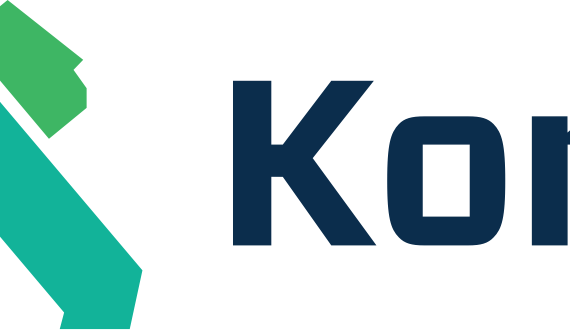Get Appointment
- contact@wellinor.com
- +(123)-456-7890
Blog & Insights
- Home
- Blog & Insights
At Keyva we often meet with clients that need just a little help, something to get them over the hump and continue on their way building out new and exciting IT capabilities. This seems to happen most often when organizations adopt new and emerging technologies. Often teams haven't built up their internal skills and capabilities around tech like Kubernetes or automation platforms such as Red Hat Ansible. Or, perhaps the team is already very skilled, but want someone to help with their OpenShift 3.x -> 4.x upgrade path, or need someone to write a new Ansible module so that they can expand their ability to offer automation capabilities via their playbooks.
There hasn't been a good way to get this kind of incremental help – no granular consumption model for technical expertise – it's not a function of your vendor's L1 support. Your vendor will tell you to buy a TAM or their own expensive consulting services. It's also not something readily available in the community at large. There are user forums and networks for days, but will you get a response to your questions? Will the responses be correct?
Keyva created Guru Services to address this exact issue. It's more than L1 support, not as heavy as a consulting engagement, it's enterprise grade and far more reliable than crowdsourcing the community for answers and assistance.
Guru Service is just as easy to use: choose from 3 different service levels and you're on your way. You'll have access to our client portal from which you can schedule your On Demand Guru. We'll send you a meeting invite with web conference information and you'll be over the hump and on your way in no time. We currently provide On Demand Gurus for Red Hat Ansible, OpenShift, and Kong and are actively adding technologies to our suite of Guru Services. To learn more about these offerings, check out our vendor pages for Kong (https://keyvatech.com/kong-enterprise/) and Red Hat (https://keyvatech.com/red-hat/). Reach out to our Keyva team at: info@keyvatech.com to request additional information or a quote on our Guru Services .
[post_title] => The On Demand Guru [post_excerpt] => [post_status] => publish [comment_status] => closed [ping_status] => closed [post_password] => [post_name] => the-on-demand-guru [to_ping] => [pinged] => [post_modified] => 2023-06-28 18:01:14 [post_modified_gmt] => 2023-06-28 18:01:14 [post_content_filtered] => [post_parent] => 0 [guid] => https://keyvatech.com/?p=2823 [menu_order] => 0 [post_type] => post [post_mime_type] => [comment_count] => 0 [filter] => raw ) [1] => WP_Post Object ( [ID] => 2742 [post_author] => 7 [post_date] => 2020-07-15 12:00:59 [post_date_gmt] => 2020-07-15 12:00:59 [post_content] =>By Brad Johnson, Lead DevOps Engineer
In this tutorial we are going to get Rancher set up for testing and development use. Rancher is fully open-source and allows us to easily deploy a Kubernetes cluster in VMware with only minimal configuration. The intent of this tutorial is to give you a base for a scalable development cluster where you can test deploying applications or configuring other Kubernetes software without setting up DNS or external load balancers.
We will use VMware vSphere 6.7 for our deployment. For the OS and software versions we are going to use the ones recommended by Rancher support. As of May 2020, Docker currently has an issue with cluster DNS and firewalld interfering with each other in CentOS/RHEL 8, so we will be using CentOS 7 and Docker 19.03.x for our management server, however you can use any supported OS. For the Master and Worker nodes we will be using RancherOS or CentOS. Using RancherOS eliminates the need to build a custom VM template in vSphere that uses cloud-init.
Requirements for this exercise:
- Admin access to vSphere or a service account with access.
- Ability to create RHEL/CentOS 7 VMs in vSphere.
- Guest VM network has internet access.
In this deployment Rancher has two primary components, the Rancher cluster manager and the Kubernetes cluster we will manage. For production use, the cluster management component would be a container deployed on its own kubernetes cluster. For ease of install and use in a testing and lab deployment, we can simply deploy the management application as a Docker container on a single server. This configuration is not recommended for production and cannot be converted into a production scenario later. If you want a single node cluster manager that can be converted into production ready setup, then you can deploy the management container on a one node kubernetes cluster which could then later be scaled up.
Rancher management server deployment
All commands run as root or with sudo unless noted:
Spin up a standard or minimal CentOS/RHEL 7 server, 2 CPU, 4GB RAM. I used a 100GB thin provisioned primary disk.
Install docker using the Rancher script. Alternatively, install by hand using documentation from docker.
curl https://releases.rancher.com/install-docker/19.03.sh | sh
Create a directory for persistent Rancher data storage
mkdir /opt/rancher
Run Rancher container with persistent data mount listening on port 80/443. This uses a docker self signed cert for SSL.
docker run -d --restart=unless-stopped -p 80:80 -p 443:443 -v /opt/rancher:/var/lib/rancher rancher/rancher:latest
Log in to the rancher web interface using your web browser. The first login will prompt you to set the password for the admin user. Set a password and you should see the main management user interface.
Optional - Creating a CentOS 7 node template for cluster nodes that includes cloud-init.
Cloud-init will allow you to specify additional configuration in Rancher that happen when Rancher creates new nodes, like firewall settings.
- Boot a new VM with a CentOS iso attached and install the OS manually
- Customize disk layout as needed
- Leave the system as DHCP
- Set a default root password
- Make any changed needed by your org
- After booting the system, clean things up so you can turn it into a VM. We have created a script for this, please edit as needed. This sets selinux to permissive as Rancher may have issues with the dns service in enforcing mode without additional configuration. The last command in this script will shut down the VM
https://raw.githubusercontent.com/keyvatech/blog_files/master/centos7_cloudinit_vmtemplate.sh
In vCenter find the VM, right-click on it, then select Clone > Clone To Template.
This template can now be used in Rancher with cloud-init for additional provisioning.
Now we can create your new Rancher cluster. Note that the Rancher coredns workload will not with with selinux set to enforcing. If you require enforcing mode you will need additional configuration. It is also important to use consistent DNS names when deploying, FQDNs are best, but do not mix short and full hostnames as it causes certificate issues. Rancher will generate self signed certs if you do not provide your own.
1) From the main web interface cluster page click add cluster, then select vSphere
2) Enter a cluster name like "rancher1"
3) Create a node template for your nodes. This can be used for both master and worker nodes.
- Click "Add Node Template"
- Fill out the Account Access section with your vSphere login info. If the credentials worked you will see the scheduling section populate. If it failed, you can add a new credential with a new name, then delete the ones that didn't work later by clicking on the user profile picture and selecting "cloud credentials".
- Fill in the scheduling information for your data center, resource pool, data store and folder.
- Edit the instance options and specify 2 CPUs and 4096MB RAM or more.
- Under Creation Method select either "Install from Boot2Docker ISO (legacy)" or the CentOS 7 node template if you made one.
- If you are using a CentOS template with cloud-init fill in the Cloud Config YAML section. We have created the following config which handles firewall config. You can extend this as needed or modify it and create a different template for each node type if desired.
https://raw.githubusercontent.com/keyvatech/blog_files/master/rancher-centos7-cloud-init-config.txt
- Select a Network to deploy to.
- Review the remaining settings and adjust if you need them in your environment.
- Name the template at the bottom of the page. The template can likely be used for multiple types if desired so keep the name generic. I prefer to use names that indicate node OS and resources like "centos7-2CPU-4GB"
- Click create.
4) Enter the name prefix for your master and worked nodes. For example, "rancher1-master" and "rancher1-worker", when nodes are created a number will be appended to the end.
5) For the master node select the etcd and control plane checkboxes
6) For the worker node select the worker checkbox.
7) Click Create at the bottom of the page. Rancher will now provision your nodes in vCenter.
You should now have a basic functional Kubernetes cluster.
If you are interested in deploying Windows worker nodes with Rancher please see our post here.
Helpful links:
https://rancher.com/support-maintenance-terms/#2.4.x
https://rancher.com/docs/rancher/v2.x/en/installation/requirements/
If you have any questions about the steps documented here, or have any feedback or requests, please let us know at info@keyvatech.com.
This guide will walk through how to set up Red Hat Ansible Tower in a highly-available configuration. In this example, we will set up 4 different systems – 1 for PostgreSQL database (towerdb), and 3 web nodes for Tower (tower1, tower2, tower3).
We will be using Ansible Tower v3.6 and PostgreSQL 10, on RHEL 7 systems running in VMware for this technical guide. The commands for setting up the same configuration on RHEL 8 will be different for some cases. This guide does not account for clustering of the PostgreSQL database. If you are setting up Tower in HA capacity for Production environments, it is recommended to follow best practices for PostgreSQL clustering, to avoid a single point of failure.
First, we will need to prep all the RHEL instances by enabling the Red Hat repos. All the commands below are to be run on all 4 systems – towerdb, tower1, tower2, tower3
subscription-manager register
subscription-manager refresh
subscription-manager attach –-auto
subscription-manager repos –-list
subscription-manager repos --enable rhel-7-server-rh-common-beta-rpms
subscription-manager repos --enable rhel-7-server-rpms
subscription-manager repos --enable rhel-7-server-source-rpms
subscription-manager repos --enable rhel-7-server-rh-common-source-rpms
subscription-manager repos --enable rhel-7-server-rh-common-debug-rpms
subscription-manager repos --enable rhel-7-server-optional-source-rpms
subscription-manager repos --enable rhel-7-server-extras-rpms
sudo yum update
sudo yum install wget
sudo yum install python36
sudo pip3 install httpie
Also:
- a) Update the /etc/hosts file on all 4 hosts with entries for all systems
- b) Add and copy thesshkeys on all systems
On the Database system (towerdb), we will now set up PostgreSQL 10
sudo yum install https://download.postgresql.org/pub/repos/yum/reporpms/EL-7-x86_64/pgdg-redhat-repo-latest.noarch.rpm
sudo yum install https://download.postgresql.org/pub/repos/yum/reporpms/EL-7-x86_64/pgdg-redhat-repo-latest.noarch.rpm
sudo yum install postgresql10 postgresql10-server
Initialize the database
/usr/pgsql-10/bin/postgresql-10-setup initdb
systemctl enable postgresql-10
systemctl start postgresql-10
Verify you can log in to the database
:~nbsp;sudo su – postgres
:~
nbsp;Psql
# \list
This command will show you the existing (default) database list.
Next, we will configure the database to make sure it can talk to all the Tower web nodes:
sudo vi /var/lib/pgsql/10/data/pg_hba.conf
Add/update the line with 'md5' entry to allow all hosts:
host all all 0.0.0.0/0 md5 Update the postgresql.conf file
sudo vi /var/lib/pgsql/10/data/postgresql.conf
Add/update the entry to listen to all incoming requests:
listen_addresses = '*'
Restart the database services, to pick up the changes made:
sudo systemctl restart postgresql-10
sudo systemctl status postgresql-10
On each of the Tower web nodes (tower1, tower2, tower3), we will set up the Ansible Tower binaries:
mkdir ansible-tower
cd ansible-tower/
wget https://releases.ansible.com/ansible-tower/setup-bundle/ansible-tower-setup-bundle-3.6.2-1.el7.tar.gz
tar xvzf ansible-tower-setup-bundle-3.6.2-1.el7.tar.gz
cd ansible-tower-setup-bundle-3.6.2-1
python -c 'from hashlib import md5; print("md5" + md5("password" + "awx").hexdigest())'
md5f58b4d5d85dbde46651335d78bb56b8c
Where password will be the password that you will be using a hash of, when authenticating against the database
Back on the database server (towerdb), we will go ahead and set up the database schema pre-requisites for Tower install:
:~nbsp;sudo su – postgres
:~
nbsp;Psql
postgres=# CREATE USER awx; CREATE DATABASE awx OWNER awx; ALTER USER awx WITH password 'password';
On tower1, tower2, tower3, update the inventory file and run the setup. Make sure your script contents match on all tower web tier systems.
You will need to update at least the following values and customize them for your environment:
admin_password='password'
pg_password='password'
rabbit_mq = 'password'
Under the [tower] section, you will have to add entries for all your tower web hosts. The first entry will typically serve as the primary node when the cluster is run.
We will now run the setup script:
./setup.sh You can either copy this inventory file on the other 2 tower systems (tower2 and tower3), or replicate the content to match the content in the file on tower1, and run the setup script on the other 2 tower systems as well.
Once the setup script is run on all hosts, and it finishes successfully, you will be able to test your cluster instance. You can do so by going to one of the tower hosts URL, initiating a job template, and see which specific tower node it runs on – based on the tower node that is designated to be the primary node at that time. You will also be able to view the same console details, and logs of job runs, regardless of which tower web URL you go to.
If you have any questions or comments on the tutorial content above, or run in to specific errors not covered here, please feel free to reach out to info@keyvatech.com.
[post_title] => Clustering guide for Red Hat Ansible Tower
[post_excerpt] => This guide will walk through how to set up Red Hat Ansible Tower in a highly-available configuration. In this example, we will set up 4 different systems – 1 for PostgreSQL database (towerdb), and 3 web nodes for Tower (tower1, tower2, tower3).
[post_status] => publish
[comment_status] => closed
[ping_status] => closed
[post_password] =>
[post_name] => clustering-guide-for-red-hat-ansible-tower
[to_ping] =>
[pinged] =>
[post_modified] => 2023-06-28 18:05:17
[post_modified_gmt] => 2023-06-28 18:05:17
[post_content_filtered] =>
[post_parent] => 0
[guid] => https://keyvatech.com/?p=2361
[menu_order] => 4
[post_type] => post
[post_mime_type] =>
[comment_count] => 0
[filter] => raw
) [3] => WP_Post Object
(
[ID] => 2282
[post_author] => 7
[post_date] => 2020-03-26 11:45:40
[post_date_gmt] => 2020-03-26 11:45:40
[post_content] =>By Anuj Tuli, Chief Technology Officer
Typically when you hear about containers and Kubernetes, it is in the context of Linux or Unix platforms. But there are a large number of organizations that use Windows and .NET based applications, and they are still trying to determine the best way forward for containerization of their Windows based business critical applications.
Kubernetes added support for Windows based components (worker nodes) starting with release v1.14.
In the example below, we will join a Windows worker node (v1.16.x) with a Kubernetes cluster v1.17.x.
As of this moment, Windows worker nodes are supported on Windows 2019 operating system only. In this example, we will leverage the flannel network set up on our master node on RHEL (see instructions above).
Step 1: Download the sig-windows-tools repository from https://github.com/kubernetes-sigs/sig-windows-tools , and extract the files
Step 2: Navigate to, and update the Kubernetes configuration file at C:\<Download-Path>\kubernetes\kubeadm\v1.16.0\Kubeclustervxlan
In our instance, we will update the following values:
- Interface Name
- Control Plane details – IP address, username, KubeadmToken, KubeadmCAHash. The values for these come from the output of the kubectl join command, when it was run during set up of the master node
Step 3: Open up PowerShell console in Admin mode and install kubernetes via the downloaded script. This step requires reboot of the server
PS C:\Users\Administrator> cd C:\<Download-Path>\kubernetes\kubeadm
PS C:\<Download-Path>\kubernetes\kubeadm> .\KubeCluster.ps1 -ConfigFile C:\<Download-Path>\kubernetes\kubeadm\v1.16.0\Kubeclustervxlan.json -install
Step 4: Once K8s is installed, join it to the existing kubernetes cluster. This step takes the values you entered in the modified Kubeclustervxlan file
PS C:\<Download-Path>\kubernetes\kubeadm> .\KubeCluster.ps1 -ConfigFile C:\<Download-Path>\kubernetes\kubeadm\v1.16.0\Kubeclustervxlan.json -join
Step 5: Verify that the Windows worker node was successfully added to the cluster. You can do this by running the kubectl command from any client (Windows or Linux nodes on the cluster)
PS C:\<Download-Path>\kubernetes\kubeadm> kubectl get nodes
NAME STATUS ROLES AGE VERSION
kubemaster.bpic.local Ready master 15h v1.17.3
kubenode1.bpic.local Ready <none> 14h v1.17.3
kubenode2.bpic.local Ready <none> 14h v1.17.3
win-eo5rgh4493r Ready <none> 12h v1.16.2
If you have any questions or comments on the tutorial content above, or run in to specific errors not covered here, please feel free to reach out to info@keyvatech.com
[post_title] => Step-by-step guide: Set up a Windows worker node for Kubernetes cluster [post_excerpt] => [post_status] => publish [comment_status] => closed [ping_status] => closed [post_password] => [post_name] => step-by-step-guide-set-up-a-windows-worker-node-for-kubernetes-cluster [to_ping] => [pinged] => [post_modified] => 2020-03-26 18:42:22 [post_modified_gmt] => 2020-03-26 18:42:22 [post_content_filtered] => [post_parent] => 0 [guid] => https://keyvatech.com/?p=2282 [menu_order] => 6 [post_type] => post [post_mime_type] => [comment_count] => 0 [filter] => raw ) [4] => WP_Post Object ( [ID] => 2278 [post_author] => 7 [post_date] => 2020-03-24 15:27:04 [post_date_gmt] => 2020-03-24 15:27:04 [post_content] =>By Anuj Tuli, CTO
Keyva announces the certification of their ServiceNow App for Red Hat Ansible Tower against the Orlando release (latest release) of ServiceNow. ServiceNow announced its release of Orlando on January 23rd, 2020, which is the newest version in the long line of software updates since the company's creation.
Customers can now upgrade their ServiceNow App for Ansible Tower from previous ServiceNow Releases – London, Madrid, New York – to Orlando release seamlessly.
You can find out more about the App, and view all the ServiceNow releases it is certified against, on the ServiceNow store here: http://bit.ly/2W5tYHv
[post_title] => ServiceNow App for Red Hat Ansible Tower "NOW Certified" against Orlando release [post_excerpt] => [post_status] => publish [comment_status] => closed [ping_status] => closed [post_password] => [post_name] => servicenow-app-for-red-hat-ansible-tower-now-certified-against-orlando-release [to_ping] => [pinged] => [post_modified] => 2020-03-24 15:27:07 [post_modified_gmt] => 2020-03-24 15:27:07 [post_content_filtered] => [post_parent] => 0 [guid] => https://keyvatech.com/?p=2278 [menu_order] => 7 [post_type] => post [post_mime_type] => [comment_count] => 0 [filter] => raw ) [5] => WP_Post Object ( [ID] => 2221 [post_author] => 7 [post_date] => 2020-02-18 08:09:33 [post_date_gmt] => 2020-02-18 08:09:33 [post_content] =>By Brad Johnson, Lead DevOps Engineer
When developing automation you may be faced with challenges that are simply too complicated or tedious to accomplish with Ansible alone. There may even be cases where you are told that “it can’t be automated”. However, when you combine the abilities of Ansible and custom python using the pexpect module, then you are able to automate practically anything you can do on the command line. In this post we will discuss the basics of creating a custom Ansible module in python.
Here are a few examples of cases where you might need to create a custom module:
- Running command line programs that drop into a new shell or interactive interface.
- Processing complex data and returning a subset of specific data in a new format.
- Interacting with a database and returning data in a specific format for further Ansible processing.
For the purposes of this article we will focus on the first case. When writing a traditional linux shell or bash script it simply isn’t possibly to continue your script when a command you run drops you into a new shell or new interactive interface. If these tools also provided a non-interactive mode or config/script input we would not need to do this. To overcome this situation we need to use python with pexpect. The native Ansible “expect” module provides a simple interface to this functionality and should be evaluated before writing a custom module. However, when you need more complex interactions, want specific data returned or want to provide a re-usable and simpler interface to an underlying program for to others to consume, then custom development if warranted.
In this guide I will talk about the requirements and steps needed to create your own library module. The source code with our example is located here and contains notes in the code as well. The pexpect code is intentionally complex to demonstrate some use cases.
Module Code (Python)
#!/usr/bin/env python
import os
import getpass
DOCUMENTATION = '''
---
module: my_module
short_description: This is a custom module using pexpect to run commands in myscript.sh
description:
- "This module runs commands inside a script in a shell. When run without commands it returns current settings only."
options:
commands:
description:
- The commands to run inside myscript in order
required: false
options:
description:
- options to pass the script
required: false
timeout:
description:
- Timeout for finding the success string or running the program
required: false
default: 300
password:
description:
- Password needed to run myscript
required: true
author:
- Brad Johnson - Keyva
'''
EXAMPLES = '''
- name: "Run myscript to set up myprogram"
my_module:
options: "-o myoption"
password: "{{ myscript_password }}"
commands:
- "set minheap 1024m"
- "set maxheap 5120m"
- "set port 7000"
- "set webport 80"
timeout: 300
'''
RETURN = '''
current_settings: String containing current settings after last command was run and settings saved
type: str
returned: On success
logfile: String containing logfile location on the remote host from our script
type: str
returned: On success
'''
def main():
# This is the import required to make this code an Ansible module
from ansible.module_utils.basic import AnsibleModule
# This instantiates the module class and provides Ansible with
# input argument information, it also enforces input types
module = AnsibleModule(
argument_spec=dict(
commands=dict(required=False, type='list', default=[]),
options=dict(required=False, type='str', default=""),
password=dict(required=True, type='str', no_log=True),
timeout=dict(required=False, type='int', default='300')
)
)
commands = module.params['commands']
options = module.params['options']
password = module.params['password']
timeout = module.params['timeout']
try:
# Importing the modules here allows us to catch them not being installed on remote hosts
# and pass back a failure via ansible instead of a stack trace.
import pexpect
except ImportError:
module.fail_json(msg="You must have the pexpect python module installed to use this Ansible module.")
try:
# Run our pexpect function
current_settings, changed, logfile = run_pexpect(commands, options, password, timeout)
# Exit on success and pass back objects to ansible, which are available as registered vars
module.exit_json(changed=changed, current_settings=current_settings, logfile=logfile)
# Use python exception handling to keep all our failure handling in our main function
except pexpect.TIMEOUT as err:
module.fail_json(msg="pexpect.TIMEOUT: Unexpected timeout waiting for prompt or command: {0}".format(err))
except pexpect.EOF as err:
module.fail_json(msg="pexpect.EOF: Unexpected program termination: {0}".format(err))
except pexpect.exceptions.ExceptionPexpect as err:
# This catches any pexpect exceptions that are not EOF or TIMEOUT
# This is the base exception class
module.fail_json(msg="pexpect.exceptions.{0}: {1}".format(type(err).__name__, err))
except RuntimeError as err:
module.fail_json(msg="{0}".format(err))
def run_pexpect(commands, options, password, timeout=300):
import pexpect
changed = True
script_path = '/path/to/myscript.sh'
if not os.path.exists(script_path):
raise RuntimeError("Error: the script '{0}' does not exist!".format(script_path))
if script_path == '/path/to/myscript.sh':
raise RuntimeError("This module example is based on a hypothetical command line interactive program and "
"can not run. Please use this as a basis for your own development and testing.")
# Set prompt to expect with username embedded in it
# YOU MAY NEED TO CHANGE THIS PROMPT FOR YOUR SYSTEM
# My default RHEL prompt regex
prompt = r'\[{0}\@.+?\]\$'.format(getpass.getuser())
output = ""
child = pexpect.spawn('/bin/bash')
try:
# Look for initial bash prompt
child.expect(prompt)
# Start our program
child.sendline("{0} {1}".format(script_path, options))
# look for our scripts logfile prompt
# Example text seen in output: 'Logfile: /path/to/mylog.log'
child.expect(r'Logfile\:.+?/.+?\.log')
# Note that child.after contains the text of the matching regex
logfile = child.after.split()[1]
# Look for password prompt
i = child.expect([r"Enter password\:", '>'])
if i == 0:
# Send password
child.sendline(password)
child.expect('>')
# Increase timeout for longer running interactions after quick initial ones
child.timeout = timeout
try:
# Look for program internal prompt or new config dialog
i = child.expect([r'Initialize New Config\?', '>'])
# pexpect will return the index of the regex it found first
if i == 0:
# Answer 'y' to initialize new config prompt
child.sendline('y')
child.expect('>')
# If any commands were passed in loop over them and run them one by one.
for command in commands:
child.sendline(command)
i = child.expect([r'ERROR.+?does not exist', r'ERROR.+?$', '>'])
if i == 0:
# Attempt to intelligently add items that may have multiple instances and are missing
# e.g. "socket.2" may need "add socket" run before it.
# Try to allow the user just to use the set command and run add as needed
try:
new_item = child.after.split('"')[1].split('.')[0]
except IndexError:
raise RuntimeError("ERROR: unable to automatically add new item in myscript,"
" file a bug\n {0}".format(child.after))
child.sendline('add {0}'.format(new_item))
i = child.expect([r'ERROR.+?$', '>'])
if i == 0:
raise RuntimeError("ERROR: unable to automatically add new item in myscript,"
" file a bug\n {0}".format(child.after.strip()))
# Retry the failed original command after the add
child.sendline(command)
i = child.expect([r'ERROR.+?$', '>'])
if i == 0:
raise RuntimeError("ERROR: unable to automatically add new item in myscript,"
" file a bug\n {0}".format(child.after.strip()))
elif i == 1:
raise RuntimeError("ERROR: unspecified error running a myscript command\n"
" {0}".format(child.after.strip()))
# Set timeout shorter for final commands
child.timeout = 15
# If we processed any commands run the save function last
if commands:
child.sendline('save')
# Using true loops with expect statements allow us to process multiple items in a block until
# some kind of done or exit condition is met where we then call a break.
while True:
i = child.expect([r'No changes made', r'ERROR.+?$', '>'])
if i == 0:
changed = False
elif i == 1:
raise RuntimeError("ERROR: unexpected error saving configuration\n"
" {0}".format(child.after.strip()))
elif i == 2:
break
# Always print out the config data from out script and return it to the user
child.sendline('print config')
child.expect('>')
# Note that child.before contains the output from the last expected item and this expect
current_settings = child.before.strip()
# Run the 'exit' command that is inside myscript
child.sendline('exit')
# Look for a linux prompt to see if we quit
child.expect(prompt)
except pexpect.TIMEOUT:
raise RuntimeError("ERROR: timed out waiting for a prompt in myscript")
# Get shell/bash return code of myscript
child.sendline("echo $?")
child.expect(prompt)
# process the output into a variable and remove any whitespace
exit_status = child.before.split('\r\n')[1].strip()
if exit_status != "0":
raise RuntimeError("ERROR: The command returned a non-zero exit code! '{0}'\n"
"Additional info:\n{1}".format(exit_status, output))
child.sendline('exit 0')
# run exit as many times as needed to exit the shell or subshells
# This might be useful if you ran a script that put you into a new shell where you then ran some other scripts
# This is also a good example of
while True:
i = child.expect([prompt, pexpect.EOF])
if i == 0:
child.sendline('exit 0')
elif i == 1:
break
finally:
# Always try to close the pexpect process
child.close()
return current_settings, changed, logfile
if __name__ == '__main__':
main()
In order to create a module you need to put your new “mymodule.py” file somewhere in the Ansible module library path, typically the “library” directory next to your playbook or library inside your role. It’s also important to note that Ansible library modules run on the target ansible host, so if you want to use the ansible “expect” module or make a custom module with pexpect in it then you will need to install the python pexpect module on the remote host before running module. (Note: the pexpect version provided in RHEL/CentOS repos is old and will not support the Ansible “expect” module, install via pip instead for the latest version.)
Information on the library path is located here:
https://docs.ansible.com/ansible/latest/dev_guide/developing_locally.html
Your example.py file needs to be a standard file with a python shebang header and also import the ansible module. Here is a bare minimum amount of code needed for an ansible module.
#!/usr/bin/env python from ansible.module_utils.basic import AnsibleModule module = AnsibleModule(argument_spec=dict(mysetting=dict(required=False, type='str'))) try: return_value = "mysetting value is: {0}".format(module.params['mysetting']) except: module.fail_json(msg="Unable to process input variable into string") module.exit_json(changed=True, my_output=return_value)
With this example you can see how variables are passed into and out of the module. This also includes a basic exception handle for dealing with errors and allowing ansible to deal with the failure. This exception clause is too broad for normal use as it will catch and hide all errors that could happen in the try block. When you create your module you should only except error types that you anticipate to avoid hiding stack traces of unexpected errors from your logs.
Now we can add in some custom pexpect processing code. This is again a very basic example. The example code linked in this blog post has a complicated and in-depth example. This function would then be added into our try-except block in the code above.
def run_pexpect(password): import pexpect child = pexpect.spawn('/path/to/myscript.sh') child.timeout = 60 child.expect(r"Enter password\:") child.sendline(password) child.expect('Thank you') child.sendline('exit') child.expect(pexpect.EOF) exit_dialog = child.before.strip() return exit_dialog
There are some important things to note here when dealing with pexpect and Ansible.
- If the program hits a timeout it will raise “pexpect.TIMEOUT” and if it terminates unexpectedly it will raise “pexpect.EOF”. These exceptions will need to be either expected, with child.expect or excepted using pythons exception handling. Any other exceptions don’t really need to be handled as then are likely real errors that should cause failure and raise a stack trace.
- Always use a timeout! Be careful never to set the timeout to None as an unattended process will hang forever waiting on any new/unexpected prompt. It’s always better to set a very generous timeout over none at all. You can change the timeout multiple times in code based on how long you expect each prompt to take to come back.
- If you do not set a timeout value at all the default for the spawn class is 30 seconds. This is the timeout looking for the text in an expect method. Even if your program is outputting text to stdout, when the timeout is hit before the string is found then the program is killed and pexpect.TIMEOUT is raised.
- Don’t use print functions in python to try to send information back to Ansible. Printing to stdout with your module will cause ansible to register a failure. All output and information should be passed back through an Ansible method like “module.exit_json”.
- For debugging you may want to use the “child.logfile” facility to create log files on the remote system.
- The “child.expect” method takes regular expressions as input. If you want an explicit string you can always “import re” and use the “re.escape” method on a string to escape it.
When creating custom modules I would encourage you to give thought to making the simplest, most maintainable and modular modules possible. It can be easy to create one module/script to rule them all, but the linux concept of having one tool to do one thing well will save you rewriting chunks of code that do the same thing and also help future maintainers of the automation you create.
Helpful links:
https://docs.ansible.com/ansible/latest/modules/expect_module.html
https://docs.ansible.com/ansible/latest/dev_guide/developing_modules_general.html
https://pexpect.readthedocs.io/en/stable/overview.html
If you have any questions about the steps documented here, would like more information on the custom development process, or have any feedback or requests, please let us know at info@keyvatech.com.
[post_title] => Build custom Red Hat Ansible modules: pexpect [post_excerpt] => [post_status] => publish [comment_status] => closed [ping_status] => closed [post_password] => [post_name] => build-custom-red-hat-ansible-modules-pexpect [to_ping] => [pinged] => [post_modified] => 2022-01-26 13:18:26 [post_modified_gmt] => 2022-01-26 13:18:26 [post_content_filtered] => [post_parent] => 0 [guid] => https://keyvatech.com/?p=2221 [menu_order] => 10 [post_type] => post [post_mime_type] => [comment_count] => 0 [filter] => raw ) [6] => WP_Post Object ( [ID] => 2149 [post_author] => 7 [post_date] => 2020-01-22 18:13:59 [post_date_gmt] => 2020-01-22 18:13:59 [post_content] =>Kong Enterprise provides you the ability to rate limit the traffic for various objects using the Rate Limiting Advanced Plugin. In the example below, we will rate limit a service fronted by Kong Enterprise.
We will use our existing Kong Enterprise on RHEL 7 environment. The installation process for this environment is documented here.
First lets make sure we have an existing service we can use. If your environment needs to have a service created, you can also check out our blog on how to do so here.
We will also be using the RBAC controls and the user we set up in our blog post. If you have not yet setup RBAC you can learn how to do so here.
1) Create a service that we can use for this example
Log in to the Kong portal at https://<kong_FQDN_or_IP>:8445 and navigate to your chosen Workspace -> Services -> New Service
Fill in the fields for Service Name, Host, Path, Port and other fields as necessary
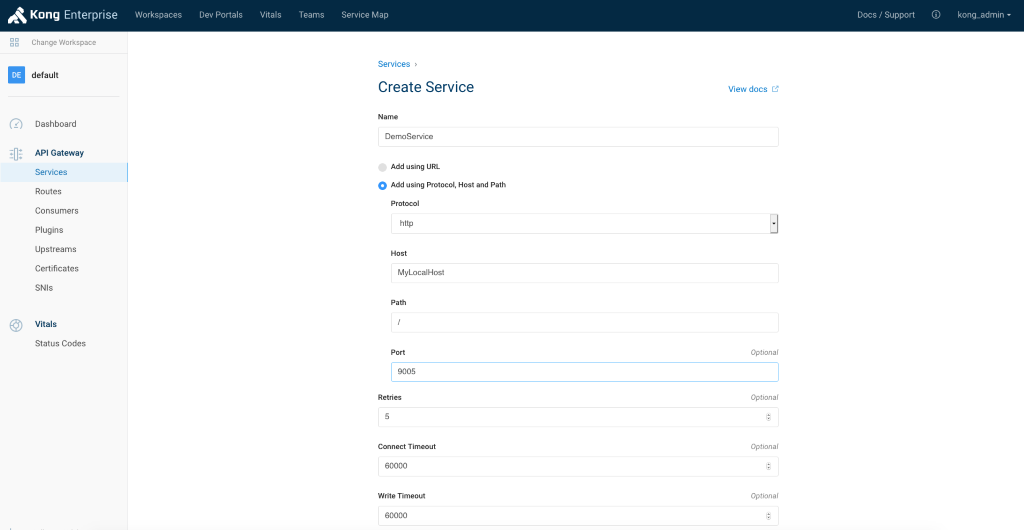
You can also run the step of creating a Service via the command line in the format below:
curl -i -X POST --url http://<kong_FQDN_or_IP>:8001/services --data 'name=DemoService' --data 'url=myurl.com'
Check to make sure the Service was created successfully by navigating through the console

Or running the following command line:
curl -i -X GET --url "http://<kong_FQDN_or_IP>:8001/services" --header "Kong-Admin-Token: rbac_user_token_1"
2) Next we will add a route for this service
curl -i -X POST --url "http://<kong_FQDN_or_IP>:8001/services/DemoService/routes" --data "hosts[]=mydemoexample.com" --header "Kong-Admin-Token: rbac_user_token_1"
3) Use the rate limiting plugin with our defined service
curl -i -X POST --url "http://<kong_FQDN_or_IP>:8001/services/DemoService/plugins" --data "name=rate-limiting-advanced" --data "config.sync_rate=0" --data "config.window_size=60" --data "config.limit=2" --header "Kong-Admin-Token: rbac_user_token_1"
This configuration means that the DemoService service should not be allowed to process more than 2 requests per 60 seconds period.
4) Now we will test running more than 2 requests against the DemoService service.
After running the request below more than twice
curl -i -X GET --url "http://<kong_FQDN_or_IP>:8000/" --header "Host: mydemoexample.com" --header "Kong-Admin-Token: rbac_user_token_1"
We get the following message:
HTTP/1.1 429 Too Many Requests
By controlling the volume of requests to a specific service, and by adding RBAC controls in front of it, you can secure a quasi-firewall for east-west traffic against internal networking vulnerabilities.
If you have any questions or comments on the tutorial content above, or run in to specific errors not covered here, please feel free to reach out to info@keyvatech.com
[post_title] => Kong Enterprise - How to Setup the Rate Limiting Advanced Plugin [post_excerpt] => [post_status] => publish [comment_status] => closed [ping_status] => closed [post_password] => [post_name] => kong-enterprise-how-to-setup-the-rate-limiting-advanced-plugin [to_ping] => [pinged] => [post_modified] => 2022-01-26 13:18:35 [post_modified_gmt] => 2022-01-26 13:18:35 [post_content_filtered] => [post_parent] => 0 [guid] => https://keyvatech.com/?p=2149 [menu_order] => 11 [post_type] => post [post_mime_type] => [comment_count] => 0 [filter] => raw ) [7] => WP_Post Object ( [ID] => 2133 [post_author] => 15 [post_date] => 2020-01-15 09:49:55 [post_date_gmt] => 2020-01-15 09:49:55 [post_content] =>If you've used the community version of the Kong API gateway, you have probably noticed that anyone that knows the server name or IP for your Kong community API gateway can access and modify existing objects including services and routes. To set up and use role-based access control Kong Enterprise version provides additional capabilities.
In this example, we will leverage the Kong Enterprise on RHEL 7 lab instance we set up earlier. You can read the install steps here.
Before getting started, please make sure enforce_rbac=on is in the kong.conf file.
Log in to https://<Kong-Enterprise-VM-IP>:8445/login using kong_admin as the username and the password you set during the install process (this is the same password you assigned during the step of EXPORT_PASSWORD='password')
Click on Teams -> RBAC Users
Create a new user rbac_user_1 with a token of rbac_user_token_1
Make sure that enabled checkbox is checked
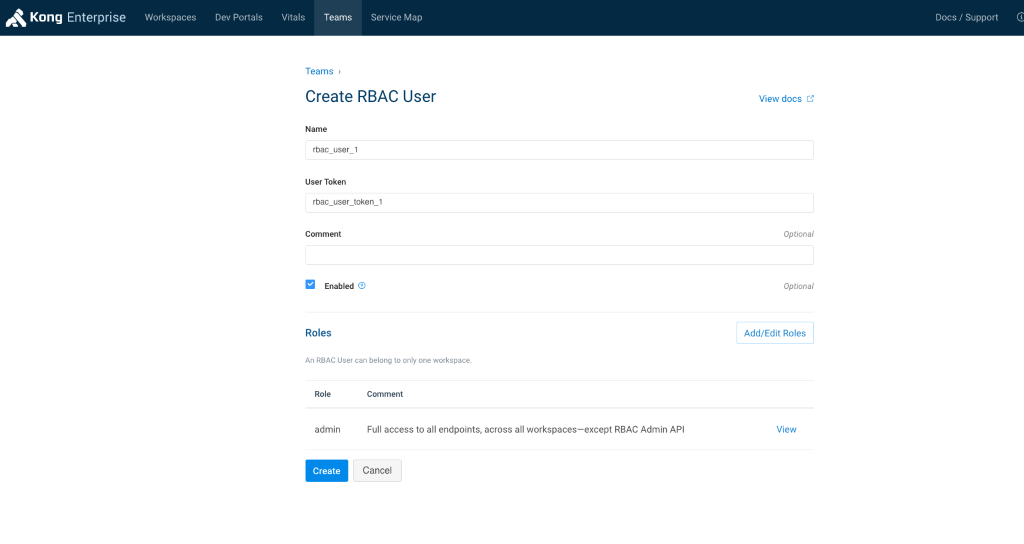
Add roles –> admin
Note that we are creating this user with 'admin' permissions, but not 'super-admin'. So it will have access to all endpoints, across all workspaces—except RBAC Admin API.
A new RBAC user, rbac_user_1, gets created
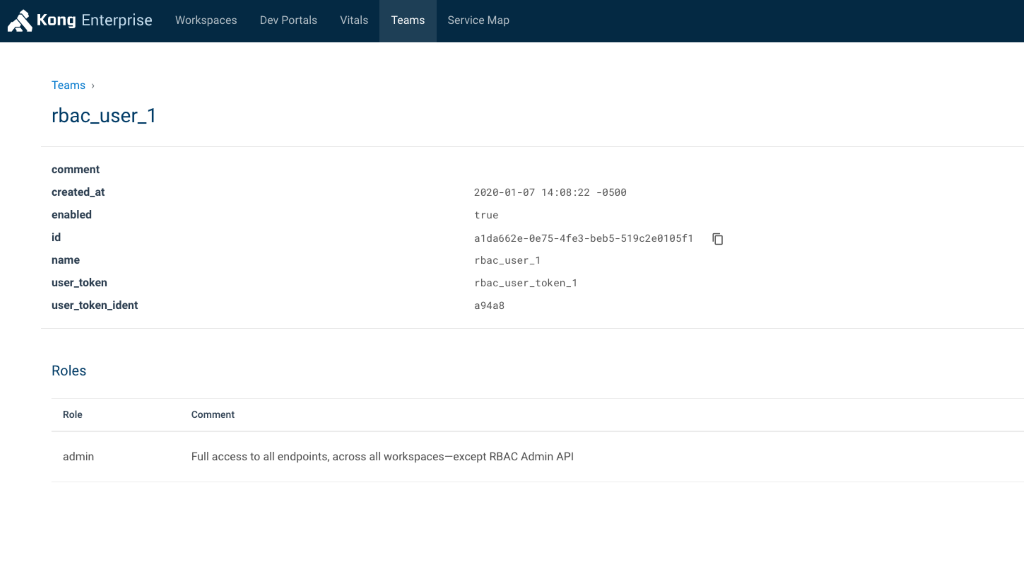
Now let's try and test the RBAC setup. We will use Postman (https://www.getpostman.com/) for this example.
First we will create a new Collection labeled 'Kong Enterprise' and then a new Request within that Collection called 'Get Services'.
Next, we will try to run a GET request against https://<Kong-Enterprise-VM-IP>:8445/services to list out all available services. If you don't pass any headers or credentials, you get the error notification "Invalid credentials. Token or User credentials required".
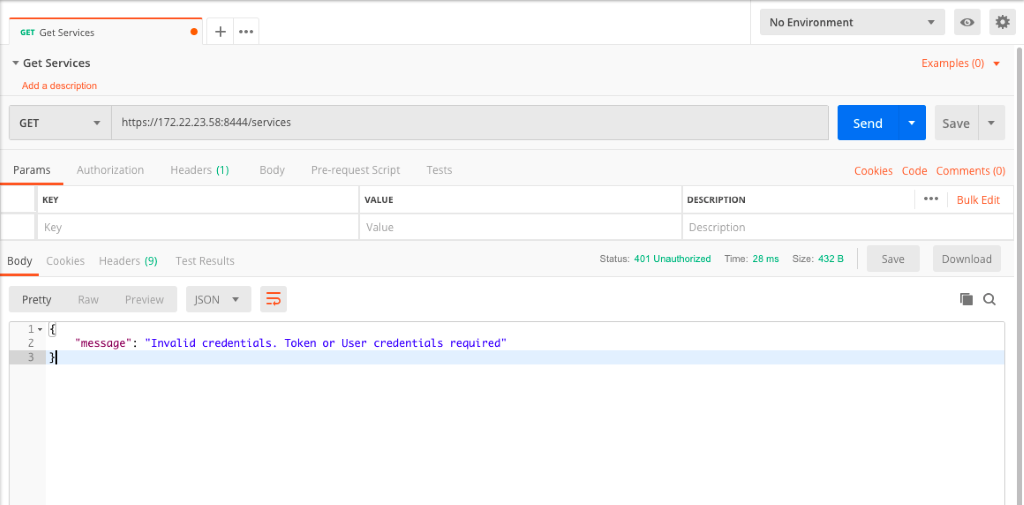
By adding the header with Kong-Admin-Token and the value of the token set in the earlier step 'rbac_user_token_1', we try to run the request again and this time it succeeds
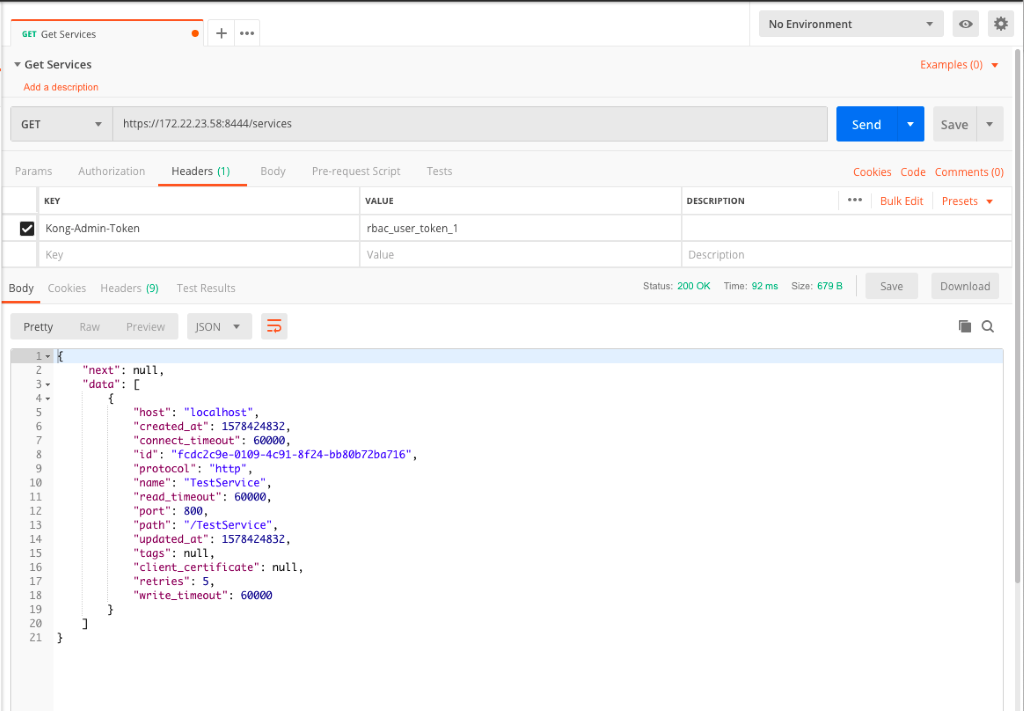
As you can see, with RBAC enabled, Kong Enterprise provides much greater control over who can access and modify various objects. The user permissions can be tailored to suit various team needs – depending upon how granular you want access to be.
If you have any questions or comments on the tutorial content above, or run in to specific errors not covered here, please feel free to reach out to info@keyvatech.com
[post_title] => Setting up Role-Based Access Control (RBAC) with Kong Enteprise [post_excerpt] => [post_status] => publish [comment_status] => closed [ping_status] => closed [post_password] => [post_name] => setting-up-role-based-access-control-rbac-with-kong-enteprise [to_ping] => [pinged] => [post_modified] => 2020-05-03 18:02:12 [post_modified_gmt] => 2020-05-03 18:02:12 [post_content_filtered] => [post_parent] => 0 [guid] => https://keyvatech.com/?p=2133 [menu_order] => 13 [post_type] => post [post_mime_type] => [comment_count] => 0 [filter] => raw ) ) [post_count] => 8 [current_post] => -1 [before_loop] => 1 [in_the_loop] => [post] => WP_Post Object ( [ID] => 2823 [post_author] => 15 [post_date] => 2020-07-24 14:38:58 [post_date_gmt] => 2020-07-24 14:38:58 [post_content] =>At Keyva we often meet with clients that need just a little help, something to get them over the hump and continue on their way building out new and exciting IT capabilities. This seems to happen most often when organizations adopt new and emerging technologies. Often teams haven't built up their internal skills and capabilities around tech like Kubernetes or automation platforms such as Red Hat Ansible. Or, perhaps the team is already very skilled, but want someone to help with their OpenShift 3.x -> 4.x upgrade path, or need someone to write a new Ansible module so that they can expand their ability to offer automation capabilities via their playbooks.
There hasn't been a good way to get this kind of incremental help – no granular consumption model for technical expertise – it's not a function of your vendor's L1 support. Your vendor will tell you to buy a TAM or their own expensive consulting services. It's also not something readily available in the community at large. There are user forums and networks for days, but will you get a response to your questions? Will the responses be correct?
Keyva created Guru Services to address this exact issue. It's more than L1 support, not as heavy as a consulting engagement, it's enterprise grade and far more reliable than crowdsourcing the community for answers and assistance.
Guru Service is just as easy to use: choose from 3 different service levels and you're on your way. You'll have access to our client portal from which you can schedule your On Demand Guru. We'll send you a meeting invite with web conference information and you'll be over the hump and on your way in no time. We currently provide On Demand Gurus for Red Hat Ansible, OpenShift, and Kong and are actively adding technologies to our suite of Guru Services. To learn more about these offerings, check out our vendor pages for Kong (https://keyvatech.com/kong-enterprise/) and Red Hat (https://keyvatech.com/red-hat/). Reach out to our Keyva team at: info@keyvatech.com to request additional information or a quote on our Guru Services .
[post_title] => The On Demand Guru [post_excerpt] => [post_status] => publish [comment_status] => closed [ping_status] => closed [post_password] => [post_name] => the-on-demand-guru [to_ping] => [pinged] => [post_modified] => 2023-06-28 18:01:14 [post_modified_gmt] => 2023-06-28 18:01:14 [post_content_filtered] => [post_parent] => 0 [guid] => https://keyvatech.com/?p=2823 [menu_order] => 0 [post_type] => post [post_mime_type] => [comment_count] => 0 [filter] => raw ) [comment_count] => 0 [current_comment] => -1 [found_posts] => 140 [max_num_pages] => 18 [max_num_comment_pages] => 0 [is_single] => [is_preview] => [is_page] => [is_archive] => [is_date] => [is_year] => [is_month] => [is_day] => [is_time] => [is_author] => [is_category] => [is_tag] => [is_tax] => [is_search] => [is_feed] => [is_comment_feed] => [is_trackback] => [is_home] => 1 [is_privacy_policy] => [is_404] => [is_embed] => [is_paged] => 1 [is_admin] => [is_attachment] => [is_singular] => [is_robots] => [is_favicon] => [is_posts_page] => [is_post_type_archive] => [query_vars_hash:WP_Query:private] => 2f81d7721674a56fe84c555fe214246a [query_vars_changed:WP_Query:private] => [thumbnails_cached] => [allow_query_attachment_by_filename:protected] => [stopwords:WP_Query:private] => [compat_fields:WP_Query:private] => Array ( [0] => query_vars_hash [1] => query_vars_changed ) [compat_methods:WP_Query:private] => Array ( [0] => init_query_flags [1] => parse_tax_query ) [query_cache_key:WP_Query:private] => wp_query:33a6633fa8c319dc69066e906d03ec49:0.52181000 1759890330 [tribe_is_event] => [tribe_is_multi_posttype] => [tribe_is_event_category] => [tribe_is_event_venue] => [tribe_is_event_organizer] => [tribe_is_event_query] => [tribe_is_past] => )






